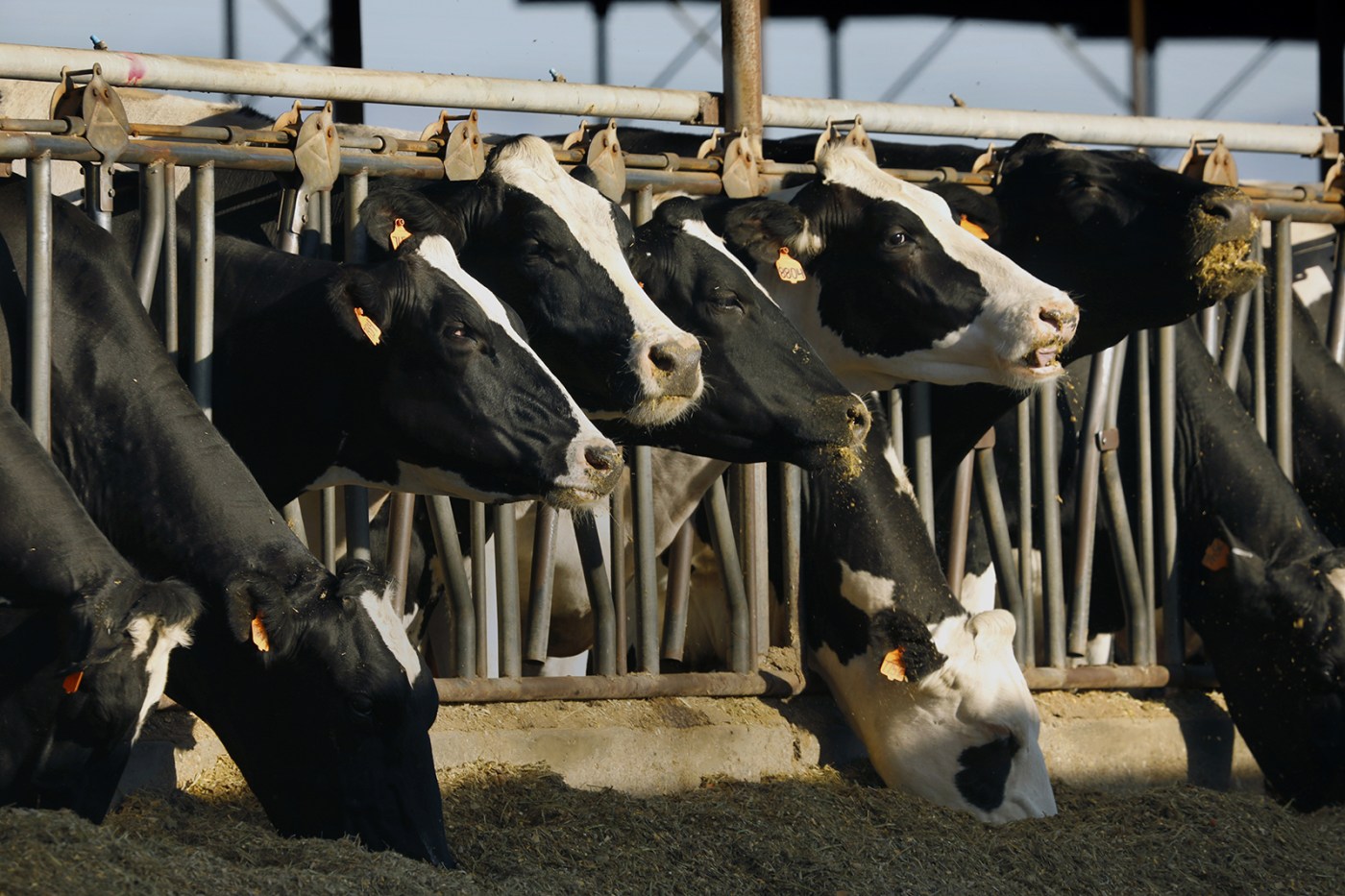Faced with a surge in the number of California cows infected with H5N1 bird flu, state officials have quarantined 34 dairies and are urging other farms to take protective biosecurity measures.
The milk supply is safe and the human risk is low, state health officials say. Although 14 cases have been reported among farmworkers nationwide, none have spread from person to person. And none are in California.
But the leap in the number of infected herds — tripling from 10 to 34 in the past week at California’s 1,000 dairies — is troubling to the state’s vibrant dairy industry, a major part of the state’s agricultural industry and the nation’s top milk producer.
“This is a tough moment,” because the state has worked to stay virus-free for nine months, said Anja Raudabaugh, executive director of Western United Dairies in Turlock. “All it took was a single breach, and it’s been a disaster.”
Climbing case counts also worry epidemiologists and health experts, who are monitoring farm workers on infected farms.
The genetic mutation that enabled the virus to jump from birds to cows and other mammals brings it one step closer to a human outbreak, they say. The flu pandemic of 1918, which killed more than 50 million people and sickened 500 million others worldwide, was caused by a virus that began with infected birds.
“I’m extremely concerned,” said John Korslund, a retired U.S. Department of Agriculture veterinarian epidemiologist, who studies livestock diseases. “The virus seems highly infectious between herds in areas with dense cattle populations, such as the Central Valley.”
“The virus is a great ‘shape-shifter.’ How it behaves today likely will change in the future,” he said. “We are at great risk of multiple poultry outbreaks and introductions into workers, wildlife, and domestic species like feral cats, rats and mice.”
An investigation is still ongoing into how the virus slipped in from outside the state, where 237 herds in 14 states are affected, said state veterinarian Dr. Annette Jones.
Genetic tests show that it wasn’t introduced by a wild bird, but was carried in on equipment or out-of-state cattle, she said. According to one rumor, California cattle were exposed when they were shipped to Idaho, but then returned, with falsified travel documents. Under state law, cows entering from infected states, like Idaho, must be inspected and test negative.
As soon as a farm tests positive, it is quarantined under the legal authority of the state veterinarian. This requires increased biosecurity and limits the movement of cattle off the farm. Employees are required to change clothes as they come and go. The state is also quarantining dairy farms within six miles of an infected herd or have contact with an infected herd.
Officials are not naming the infected counties or dairies, although the early cases were reportedly in Tulare County. Disclosure would pose a biosecurity risk, because curious onlookers might travel to the farms, said Jones.
This frustrates some farmers.
“How do you stop something if you don’t know where it’s at?” said Joe Bento of Modesto’s Valley Milk Simply Bottled, which sells raw milk to Bay Area customers. “This is our livelihood. These are our customers. And this could shut down the dairy forever.”
In poultry outbreaks, the location is disclosed, said Korslund. “The same courtesy should be applied to dairy herds.”
Every producer in California should assume that neighboring producers are infected or at high risk of being infected, he said.
In the southern San Joaquin Valley, dairies are taking aggressive biosecurity steps, said Raudabaugh.
They are preventing all non-essential visitors, such as salesmen. Roadblocks, like hay bales, stop traffic. Deliveries of medicines and other important items are deposited into a secure location on the road, outside the dairy. Livestock trailers are being power washed with a bleach solution before and after moving cattle.
But in the northern stretches of the valley, compliance is more casual.
“What we would like to see is, no matter where they’re located in the state, is to increase their own biosecurity,” said Jones.
Over the past four years, the deadly and highly contagious virus has circled the globe, taking a staggering toll on birds in more than 80 nations.
After emerging in 2020, the virus triggered major outbreaks in Europe, Africa and Asia. It arrived in the United States in January 2022 and stormed through the nation’s largest concentrations of poultry farms in the East and Midwest.
A genetic analysis by University of Arizona evolutionary biologist Michael Worobey revealed that there was likely a single transmission from bird to cows — probably in Texas in late 2023.
As it spreads in cattle, there are more opportunities for it to develop a new mutation that creates more severe illness in cattle — or introduces it to people.
The more the H5N1 is spread unchecked, the bigger the “reservoir” and chances for further mutations to take hold, according to Scripps Research Translation’s Institute Eric Topol, professor of molecular medicine.
More research is needed to understand the routes of transmission and clinical illness, said Korslund. Cows appear to be most infectious to each other, as well as to human employees, before they get sick — so an infection may not be caught promptly.
Further spread could reduce the state’s milk, cheese and yogurt production. Treatment has improved, so cows no longer die from infection. But they must be taken out of the milking rotation. Nearly all of the milk, cheese and yogurt in the state’s school lunch program, as well as the Women, Infants & Children (WIC) Program, comes from California cows.
It may already be too late to rid California’s cattle herds of the flu virus.
“It’s on everybody’s mind,” said Jack Hoekstra of the California Cattlemen’s Association, a dairy farmer in Oakdale. “It’s just a matter of when and where, and what the scale is going to be.”












